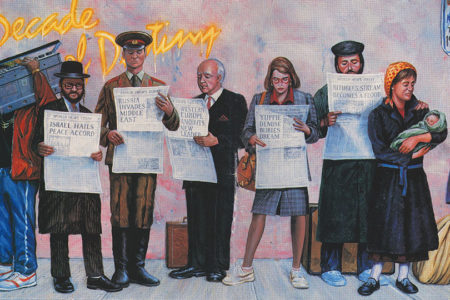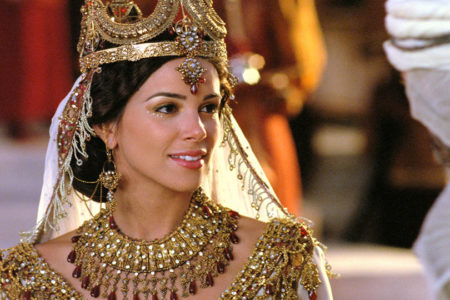Europe and 1992
A Significant Prophecy
Over 2,500 years ago God gave the Prophet Daniel a significant prophetic dream or vision. It is recorded in Daniel 7. In this prophecy God revealed the future course of Gentile world dominion from Daniel’s time up to the Second Coming of Messiah. God indicated that Babylon (represented in the vision by a winged lion, v. 4), which was the great power in Daniel’s day, would be succeeded by Medo-Persia (represented by a bear, v. 5), that Medo-Persia would be followed by Greece (represented by a four-winged, four-headed leopard, v. 6), and that Greece would be conquered by Rome (represented by a dreadful nondescript beast, vv. 7–8).
The beast which represented the Roman Empire in Daniel’s vision was so terrifying and ferocious that there was no living animal which could represent it. The major thing emphasized concerning this beast was its overwhelming destructive power. With iron teeth it devoured and crushed everything in its way and trampled all else under its feet. This was an apt description of the ancient Roman Empire, for it was able to crush and shatter the ancient world in an unparalleled way through its great military might.
This unusual beast had ten horns on its head. An angel told Daniel that the ten horns represented ten kings (v. 24). Orientals regarded kings and their kingdoms as being synonymous with each other; thus, the ten horns represented ten rulers and their kingdoms. The fact that the ten horns were on the head of the fourth beast and were, therefore, part of it, indicated that the ten rulers and their kingdoms would belong to the Roman Empire.
The angel told Daniel that these ten rulers (and their kingdoms) would arise out of the Roman Empire (v. 24). The ten horns represented a latter stage in the history of the Roman Empire. The first stage was the beast or conquering stage (the ancient Roman Empire). The latter stage could be called the ten horn or ten kingdom stage. Thus we are told that the Roman Empire would experience ancient and modern phases. The latter is the period we have come to know as the last days.
The fact that the ten rulers and their kingdoms would all belong to the same Roman Empire indicated that in the latter stage of its history the Roman Empire would consist of a ten-nation confederation.
In a parallel dream which God gave to King Nebuchadnezzar of Babylon (Dan. 2), this latter stage of the Roman Empire was portrayed as a mixture of iron and clay (vv. 41–43). Daniel interpreted the iron and clay mixture as follows: Just as iron is strong, so the Roman Empire in its latter stage would be strong. Just as clay is characterized by brittleness, so the latter stage of the Roman Empire would be characterized by division. Different groups of people would combine with each other to form the latter stage of the empire, but they would not adhere completely to one another, just as iron and clay do not combine completely with each other.
The combination of concepts from Daniel 7 and 2 leads to the conclusion that God was indicating that the latter stage of the Roman Empire’s history would consist of a ten-nation confederation. These ten nations would confederate for the sake of strength in the world, but they would not combine to the extent of losing their national identities or control over all their own domestic policies.
It should be noted that the Roman Empire never consisted of a ten-nation confederation in past history. In light of this fact, one is forced to conclude that the ten-nation confederation, which will constitute the latter stage of the Roman Empire’s history, must be formed in the future.
A Significant Dream
The western half of the ancient Roman Empire fell in 476 A.D. Over the centuries since that time, western man has persistently held on to the dream of continuing or reviving the Roman Empire.
Between 768 and 800 A.D. Charlemagne, king of the Franks, brought more of Western Europe under his rule than had been under one man since the fall of Rome in 476 A.D. On Christmas Day, 800 A.D., the pope crowned Charlemagne “Emperor of the Romans.” “Thus was the Roman Empire revived in the West; and new Rome, led by a Teuton, took the place of the old Roman Empire.” However, this empire fell apart after Charlemagne died in 814 A.D.
The idea of the Roman Empire was revived again in 962 A.D. when the German ruler, Otto the Great, started the Holy Roman Empire. This form of the empire lasted until 1806 when Napoleon ended it.
From his youth onward, Napoleon associated power, greatness, and fame with Rome. He considered himself to be a Roman. He craved the restoration of the forms of Roman imperialism, and he himself wanted to be an emperor. Napoleon expressed the desire to reconstruct the Roman Empire of Charlemagne, and he called himself “Charlemagne.” He thought that Europe should be ruled by one emperor who would have kings under him. He laid plans “to reunite Europe in the bonds of an indissoluble federation” to which he referred as “a United States of Europe.” On December 2, 1804, Napoleon crowned himself “Emperor” with a Roman crown of gold leaves. Later he said, “I am a Roman emperor, in the best line of the Caesars.” Napoleon’s empire disintegrated after his defeat at Waterloo in 1815.
The idea of a western Roman Empire was revived again when Bismarck, the Iron Chancellor of Germany, conquered France in 1870. In 1871 the Germans called their new empire “the Second Reich.” They regarded the old Holy Roman Empire (962–1806 A.D.) as being the First Reich; thus, the new empire was considered to be the continuation of the old empire. The emperor of the Second Reich, Wilhelm I was given the title “Kaiser” (the German form of Caesar). The Second Reich ended, however, in 1918 after Germany’s surrender to the allied forces of World War I.
Between World Wars I and II Count Richard N. Coudenhove-Kalergi began a movement to get European nations to establish a “United States of Europe.” In 1926 he led in the organization of the Pan-European Congress in Vienna.
On February 15, 1930, Winston Churchill published an article entitled “The United States of Europe” in The Saturday Evening Post. He encouraged a federation of the European nations on the continent. Other European leaders liked the idea of such a federation and worked hard for it, but in the 1930s a strong reaction against such a union set in.
As a youth, Mussolini dreamed about a revival of the ancient glory of Rome. In 1921, when his black shirt troops occupied Rome, he said, “It is destiny that Rome again takes her place as the city that will be the director of the civilization of all western Europe. On May 9, 1936, after Italy’s conquest of Ethiopia, Mussolini proclaimed, “the reappearance of the Empire on the fated hills of Rome.” He organized his Fascist militia with Roman names and symbols, reinstituted the Roman salute and form of address, placed the Roman Eagle on the capitol, and named military organizations of boys “Sons of the She-Wolf,” after Romulus and Remus, the founders of ancient Rome. When visiting Rome, Hitler declared that the Roman Empire had been resurrected through the efforts of Mussolini. But by 1943 the course of World War II had gone so strongly against Italy and Mussolini that he was dismissed from office and taken to jail by decree of King Victor Emmanuel on July 25. “So fell, ignominiously, the modern Roman Caesar.”
In 1940 Count Coudenhove-Kalergi fled Nazi oppression in Europe and came to New York City where he set up a seminar on European union. This seminar drew up a proposed constitution of the United States of Europe. This idea of a federated Europe caught on with U. S. statesmen. In 1944 the United States Congress adopted the idea of the unification of Western Europe as part of its war policy. President Truman and the State Department fully endorsed the idea.
In July 1944 national resistance movements of Europe issued a joint declaration stating that “Federal union alone could ensure the preservation of liberty and civilisation on the continent of Europe.”
In 1944 several German generals plotted to overthrow Hitler and Nazism. They planned to ask the Western Allies for an armistice and hoped for the establishment “of a ‘constructive peace’ within the framework of a United States of Europe.”
After World War II Churchill strongly advocated European union. On September 19, 1946, he talked about Europe’s ills at the University of Zurich: “What is the sovereign remedy? It is to recreate the European family, or as much of it as we can, and to provide it with a structure under which it can dwell in peace, safety, and freedom. We must build a kind of United States of Europe.”
From May 7 to 10, 1948, 750 delegates from all over free Europe gathered at The Hague and established the Congress of Europe for the purpose of unifying Europe. This movement became known as the European Movement.
France, Germany, Belgium, the Netherlands, Italy, and Luxembourg established the European Coal and Steel Community on April 18, 1951. The goal of this organization was to pool the iron, steel, and coal resources of these countries.
On March 25, 1957, statesmen from the six nations of the European Coal and Steel Community met on the Capitoline Hill in Rome and established the European Economic Community (the Common Market) and the European Atomic Energy Community (Euratom). The goal of the Common Market was to wipe out all economic barriers between the six member nations within 12 to 15 years. Western European leaders expressed the hope that the Common Market would become the nucleus of a future United States of Europe.
Konrad Adenauer, postwar West Germany’s outstanding Chancellor, made significant statements concerning the unification of Europe: “I want to stay alive longer for only one reason—to see a United States of Europe in my time.” “The integration of Europe must be achieved. I am convinced that it is the sole salvation for the Christian West.” “The necessity for union for economic, political, and military reasons is incontestable.”
In 1958 one observer of the movement for European unity stated that it “has reconceptualized and brought up-to-date the historic ideal of European unity, dating back to Roman times.”
It is interesting to note how many key leaders over the years have dreamed of a confederation of nations in Europe (a confederation very similar to that revealed in Daniel 2 and 7) and have associated that confederation with a continuation or revival of the Roman Empire (just as Daniel 2 and 7 associate the confederation of those chapters with a latter stage of the Roman Empire’s history).
A Significant Prospect
The Common Market did not accomplish the goal it set for itself when it was established in 1957. Although there was much talk about economic unity, all economic barriers were not wiped out between member nations within 12 to 15 years (1969 to 1972).
It was not until June 1985 that the Common Market began to actively pursue the fulfillment of its goal by developing a planned strategy, building the organizational structure necessary to carry out the strategy, and setting a deadline for fulfillment. December 31, 1992, is the deadline for European economic unity becoming reality in the truest sense.
According to the planned strategy, by the end of 1992 all national barriers (customs, tariffs, and non-tariff barriers) to travel, employment, investment, and trade will be eliminated between the present 12 member nations (Belgium, Denmark, France, Greece, Ireland, Italy, Luxembourg, the Netherlands, Portugal, Spain, the United Kingdom, and West Germany) of the Common Market.
This means that a major part of Europe, which has been severely handicapped by divisions since the fall of Rome in 476 A.D., is on the verge of becoming a single economic market with a population of over 322 million, a gross national product of over $4.2 trillion, and more than a quarter of the world’s trade (the United States, with a population of 241 million, has a gross national product of a little over $4.4 trillion).
Several writers have expressed the significance of the formation of this single European Community. One has stated that “the EC is potentially the richest market the world has ever known.”
Another has declared that Europe “will finally be restored to the first rank of economic powers.”
Still another has written several comments: “Europe will become the world’s largest single marketplace: 320 million educated and rich consumers, ready to take on the world” “In a pivotal decade, the continent will have transformed itself from a patchwork quilt into a tough and single-minded competitor of the U. S. and Japanese mega-economies—encompassing an internal market nearly as large as both countries combined” “It is a revolution in the making.”
It would appear, then, that the 1992 formation of the European Economic Community could radically alter the present economic order of the world. Europe has the potential of becoming the economic superpower of the globe.
Such a development could prompt further significant changes for Europe. A common economy could be the forerunner of a common political system. One writer observed that a common economy “is the absolute precondition for accomplishing the long-term European dream: a real political union that will restore Europe to its role as a world power.”
Caspar Weinberger indicates that some Common Market leaders already desire more than economic unity for Europe. “In short, the more ambitious of these planners really want a new, single country, the United States of Europe, with a diminished role for each of the 12 individual nations. As a result, they are proposing more and more ECM control over matters not originally thought of as required by the unification of markets and trade … other things that intrude on the sovereignty of the 12 nations.”
Such proposals have prompted “a furious public debate over how much sovereignty individual nations should concede to the EC—and what kind of Europe they should build.” England, in particular, has expressed great concern. Prime Minister Thatcher has vocalized fear of “a European superstate exercising a new domination from Brussels.” She sees the main issue as being “the conflict between the sovereignty of individual nation-states and the dream of a European federation.”
Even within the realm of economic unity, some members of the Common Market are opposed to such proposals as a European central bank, a common European currency, and the harmonization of value-added taxes.
It would appear, then, that although the 12 nations of the Common Market are committed to economic confederation for the sake of economic power in the world, not all are willing to give up their own national identities or sovereign control over certain domestic policies. In light of this, Caspar Weinberger has made the following evaluation of what will transpire in 1992: “Therefore, it seems safe to predict that the Common Market will take effect in 1992 as scheduled, that it will be far more of a true Common Market, but far less a sovereign nation than some of its most ardent supporters wish.”
A Significant Question
The direction in which Europe is heading for 1992 could produce radical changes worldwide in scope during the decade of the 1990s. This prospect prompts a significant question: Will the formation of the European Economic Community in 1992 fulfill the revelation of the latter stage of the Roman Empire given in Daniel 2 and 7?
Honesty requires the following answer to that question: At this point in time, only the Lord knows. On the one hand there are some intriguing similarities between Europe’s direction and the Daniel prophecies. Both involve a group of nations which confederate together for the sake of power in the world, but which do not combine to the extent of losing their own national identities or control over all their own domestic policies. In addition, just as the Daniel confederation is to be a latter stage of the Roman Empire, so the coming European confederation is related to the dream of key European leaders of many centuries—the dream of a United States of Europe which will be a continuation or revival of the Roman Empire. In light of these similarities, Europe 1972 is an intriguing prospect.
On the other hand, at present there are some problems with saying that Europe 1992 will fulfill the Daniel prophecies. One obvious problem is the fact that the Daniel confederation will consist of ten nations, but it appears that the 1992 European Economic Community will consist of 12 nations. In addition, in light of some of the thorny issues which still stand in the way of European economic unity, some observers point out that the Common Market may not be able to accomplish its goal by 1992.
From a biblical perspective, the direction of Europe for 1992 is significant in one respect—it demonstrates that European leaders are at least thinking and moving in a direction similar to that revealed in the Daniel prophecies. The direction of Europe deserves close watch.
For a list of footnotes, write Israel My Glory, P. O. Box 908, Bellmawr, NJ 08031









The most insightful and disciplined student of the Word of God that I had the honor of studying under. So thankful that he has left these articles for those of us who remain.